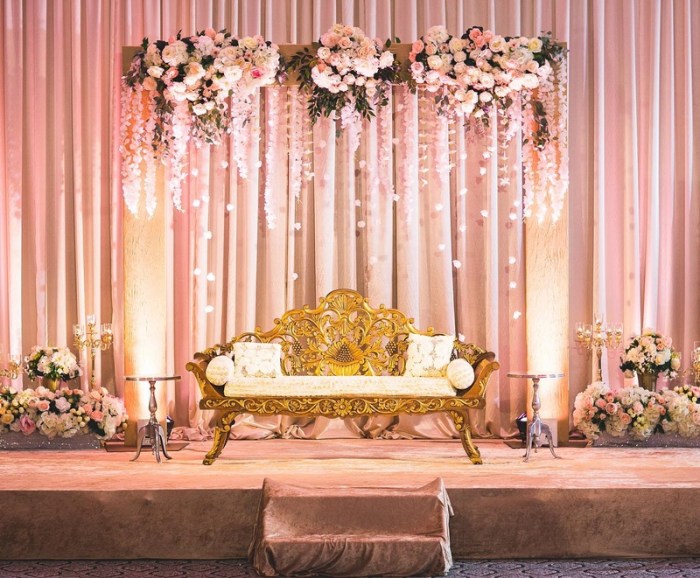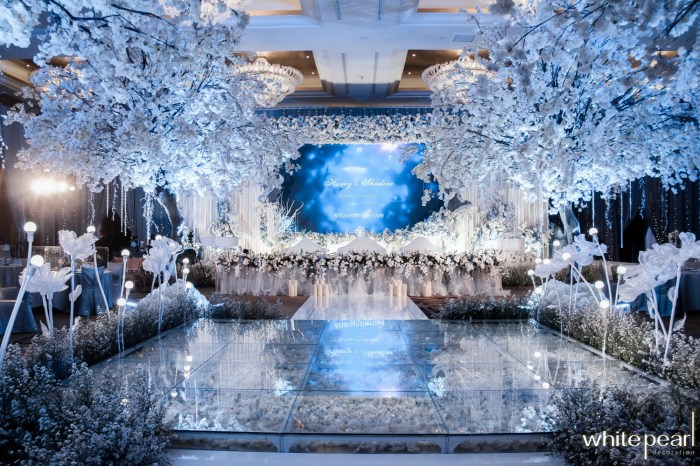The Anatomy of a Wedding Dress
Parts of the wedding dress – Choosing a wedding dress is a significant undertaking, a journey into the world of silhouettes, fabrics, and details that will culminate in the perfect expression of your personal style on your special day. This exploration delves into the key components of a wedding gown, providing insights into the various elements that contribute to its overall beauty and functionality.
Wedding Dress Silhouettes
The silhouette of a wedding dress significantly impacts its overall look and how it flatters different body types. Understanding the various options allows for a more informed choice.
| Silhouette | Characteristics | Suitable Body Types | Illustrative Description |
|---|---|---|---|
| A-line | Fitted at the shoulders and gradually widens towards the hem, creating an “A” shape. | Most body types; flattering for pear, hourglass, and apple shapes. | Imagine a gentle, consistent widening from the shoulders to the floor, like an inverted triangle. The skirt flows gracefully, allowing for movement. |
| Ballgown | Fitted bodice and a full, voluminous skirt, often with a petticoat for extra fullness. | Most body types, particularly those who want to emphasize their upper body. | Picture a princess gown with a cinched waist and a dramatic, wide skirt that flares out significantly from the waist. Think Cinderella. |
| Mermaid | Fitted from the shoulders to the knees or mid-thigh, then flares out dramatically into a wider skirt. | Hourglass, pear, and athletic body types; emphasizes curves. | Visualize a dress that hugs the body closely until it dramatically flares out, resembling a fishtail. This silhouette creates a stunning, dramatic effect. |
| Sheath | Straight, close-fitting silhouette that skims the body. | Slender body types; can be less flattering on curvier figures. | Envision a sleek, column-like dress that flows elegantly down the body without any significant flare or volume. |
| Empire | Fitted bodice just below the bust, with a flowing skirt that falls loosely from the empire waistline. | Most body types; particularly flattering for those who want to emphasize their upper body or de-emphasize their lower body. | Imagine a dress with a high waistline, just below the bust, with a soft, flowing skirt that falls gracefully to the floor. It creates a romantic, ethereal look. |
Wedding Dress Fabrics
The fabric of a wedding dress significantly influences its drape, texture, and overall aesthetic. Different fabrics offer unique properties and are suitable for various styles and seasons.
- Silk: Luxurious, smooth, and drapes beautifully; can be delicate and requires careful handling.
- Satin: Smooth, shiny, and luxurious; prone to wrinkles and may show imperfections.
- Lace: Delicate, intricate, and adds a romantic touch; can be delicate and require careful handling.
- Tulle: Lightweight, sheer, and often used for veils and overlays; easily damaged.
- Chiffon: Lightweight, sheer, and flows beautifully; prone to wrinkles and may require ironing.
Wedding Dress Construction
The construction techniques employed in creating a wedding dress are crucial for its fit, durability, and overall appearance. These techniques require skill and precision.
- Seaming: Precisely joining fabric pieces to create the desired shape and structure.
- Boning: Inserting rigid boning into the bodice to provide structure and support.
- Draping: Sculpting fabric directly onto a dress form to create specific shapes and contours.
The Wedding Dress Train: Parts Of The Wedding Dress
The train of a wedding dress adds a dramatic flair and elegance, but its length and style should be carefully considered based on the venue and the bride’s personal preference.
Train Lengths and Styles
Various train lengths offer different levels of drama and practicality.
- Chapel Train: Extends to the floor and sweeps behind the bride, reaching approximately the length from the back of the dress to the floor at the chapel. Imagine a graceful sweep that extends slightly beyond the bride’s feet.
- Cathedral Train: A long, dramatic train extending several feet behind the bride, reminiscent of the length one might see in a grand cathedral. Picture a train that extends significantly behind the bride, creating a stunning visual effect.
- Court Train: A very long train, extending significantly beyond the bride’s feet. Visualize a train that extends several feet behind the bride, creating a regal and elegant look.
- Royal Train: An extremely long train, often requiring a train bustle for easier movement. Picture an exceptionally long train that demands a bustle to manage its length and prevent tripping.
Train Attachment and Care, Parts of the wedding dress
The train is typically attached to the gown at the waist or lower back, and its care involves careful handling and potential use of a bustle for easier movement and protection.
- Attachment methods vary but typically involve careful stitching or other secure fastenings.
- Maintenance includes regular cleaning and potential use of a bustle for easier movement and protection.
Train Practicality

Source: weddingz.in
The practicality of different train lengths depends on the wedding venue and activities planned. Shorter trains are generally more practical for outdoor weddings or active brides.
The Wedding Veil
The wedding veil holds historical significance and adds a touch of elegance and mystery to the bridal look.
Veil Styles

Source: bridestory.com
| Veil Style | Length | Typical Dress Pairing | Descriptive Illustration |
|---|---|---|---|
| Birdcage | Short, often covering only the face. | Short, simple dresses; vintage-inspired styles. | Imagine a short, netting veil that partially covers the face, creating a playful, retro look. |
| Blusher | Short veil that covers the face until the ceremony. | Traditional, classic dresses. | Picture a short veil that covers the bride’s face, to be lifted during the ceremony, revealing the full bridal look. |
| Cathedral | Very long veil, often extending several feet behind the bride. | Grand, dramatic dresses; ballgowns. | Envision a long, flowing veil that extends significantly behind the bride, mirroring the length of a cathedral train. |
| Mantilla | Lace veil that typically drapes over the head and shoulders. | Romantic, bohemian, or vintage dresses. | Imagine a delicate lace veil draped elegantly over the head and shoulders, creating a romantic, ethereal look. |
Historical and Cultural Significance
The wedding veil has a rich history, symbolizing purity, modesty, and good luck in various cultures.
Veil Materials
The material of the veil significantly impacts its look and feel. Tulle provides a soft, ethereal look, while lace adds a touch of intricate detail, and silk offers a luxurious feel.
Wedding Dress Accessories
Accessories add the finishing touches to a wedding dress, enhancing its overall look and reflecting the bride’s personality and style.
Common Wedding Dress Accessories
- Jewelry: Necklaces, earrings, bracelets, and rings that complement the dress and the bride’s style.
- Headpieces: Tiaras, hair combs, flower crowns, and veils that add a touch of elegance or whimsy.
- Belts: Accentuate the waistline and add definition to the silhouette.
- Gloves: Add a touch of sophistication and elegance.
Accessory Coordination
Accessories should complement the dress style and fabric, enhancing the overall aesthetic without overpowering it.
Choosing Appropriate Accessories
The choice of accessories should align with the wedding theme and venue, ensuring a cohesive and harmonious look.
Undergarments and Alterations
Proper undergarments and alterations are crucial for ensuring a perfect fit and a comfortable, confident bride.
Importance of Undergarments
- Shapewear: Smooths the body and creates a streamlined silhouette under the dress.
- Bras: Provides support and ensures a comfortable fit.
- Slips: Prevent the dress from clinging to the body and adds a layer of smoothness.
Common Alterations
Alterations are often necessary to achieve the perfect fit and desired look.
- Length Adjustments: Adjusting the hem to the appropriate length.
- Bust Alterations: Adjusting the bodice to fit the bride’s bust size.
- Waist Alterations: Adjusting the waistline to create a flattering silhouette.
Role of a Seamstress
A skilled seamstress or tailor plays a vital role in ensuring a perfect fit, making necessary adjustments, and adding finishing touches to the wedding dress.
Answers to Common Questions
What is the difference between a cathedral and a chapel train?
A cathedral train is significantly longer than a chapel train, extending several feet behind the bride. A chapel train typically extends to the floor behind the bride, while a cathedral train trails much further.
How do I choose the right veil length for my dress?
Consider the style of your dress and the overall formality of your wedding. A shorter veil complements simpler dresses, while a longer veil suits more elaborate gowns. The length should also be proportionate to your height and the venue.
What type of undergarments are best for a wedding dress?
This depends on the dress style and your body type. Shapewear can smooth lines, while a supportive bra is essential for dresses with low necklines or strapless designs. Consider a slip to prevent the dress from clinging.
Can I alter my wedding dress after it’s purchased?
Yes, many alterations are possible, including adjusting length, bust, waist, and adding or removing sleeves. Consult a seamstress for a consultation.
How far in advance should I start the alteration process?
Ideally, begin alterations at least 6-8 weeks before the wedding to allow ample time for fittings and adjustments.
